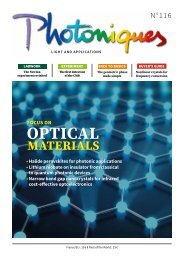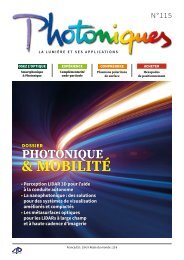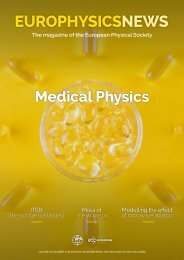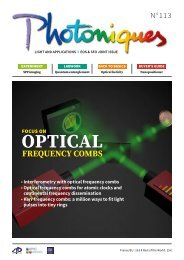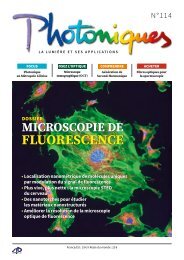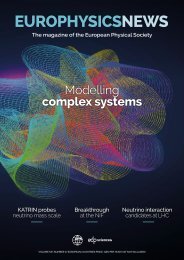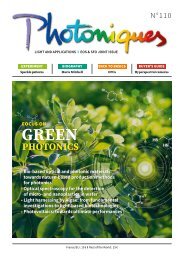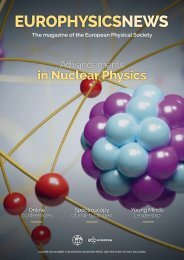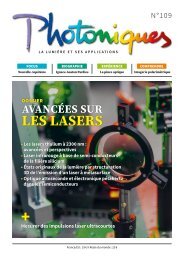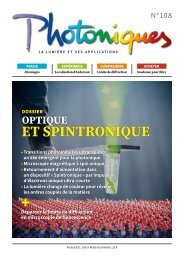Europhysics News 53-4
Europhysics News Quantum Issue
Europhysics News Quantum Issue
You also want an ePaper? Increase the reach of your titles
YUMPU automatically turns print PDFs into web optimized ePapers that Google loves.
Rydberg atoms<br />
FEATURES<br />
Since the 1980s, one can manipulate individual<br />
quantum objects (electrons, ions, photons…),<br />
and realize what was previously<br />
thought to remain Gedankenexperimente,<br />
for instance the demonstration of entanglement. Over<br />
this period, it has also been realized that harnessing the<br />
laws of quantum mechanics for practical applications,<br />
such as cryptography or computing, could lead to a<br />
second quantum revolution, with new and extremely<br />
efficient approaches to solving some problems. To do<br />
so however, one needs to exquisitely control large assemblies<br />
of quantum objects.<br />
Even if the realization of a fully-fledged quantum<br />
computer remains a formidable task, tremendous progress<br />
has been made recently in manipulating larger<br />
and larger assemblies of quantum objects. One of the<br />
earliest applications of these systems will be quantum<br />
simulation: the realization of many-body systems<br />
governed by Hamiltonians usually studied in<br />
condensed-matter physics. Here, we describe one of<br />
the most appealing platforms for quantum simulation<br />
of spin Hamiltonians encountered in magnetism,<br />
namely arrays of single atoms with programmable geometries,<br />
and that interact strongly when excited to<br />
Rydberg states. We first describe the tools used to realize<br />
this platform, and then illustrate its use through<br />
recent experiments.<br />
Experimental tools<br />
Single atoms in optical tweezers were pioneered by the<br />
group of P. Grangier at Institut d’Optique in 2001 [1].<br />
His team demonstrated that by tightly focusing a laser<br />
beam it is possible to create trapping volumes so small<br />
that, under certain conditions, only one atom fits inside.<br />
These optical tweezers are created with high-numerical-aperture<br />
optical systems, and a few milliwatts of<br />
light are enough to trap atoms from a magneto-optical<br />
trap (MOT). The atoms can be detected by fluorescence<br />
using the same optics that focuses the tweezers.<br />
During loading, when an atom enters the microtrap,<br />
it is further cooled down and stays trapped; whenever<br />
a second atom is loaded, a fast light-assisted collision<br />
takes place, leading to the loss of both atoms. This prevents<br />
the simultaneous presence of two atoms in the<br />
trap, but the loading is stochastic with an occupation<br />
probability of about 50%.<br />
This can be extended to a larger number of traps<br />
with holographic methods (Fig. 1a). By imprinting an<br />
appropriate phase in the trapping beam with a spatial<br />
light modulator (SLM), a single trap can be replicated<br />
into hundreds of traps, each of them hosting at most<br />
one atom [2]. For a long time, the non-deterministic<br />
loading of the arrays hindered the use of this platform<br />
for quantum simulation. Since 2016, a simple approach<br />
has been broadly adopted to overcome this limitation. It<br />
consists in actively sorting the atoms in the arrays with<br />
dynamical optical tweezers. This assembling process obtains<br />
filling fractions near unity, and one can currently<br />
generate two- and three-dimensional [3] defect-free<br />
arrays containing more than 200 atoms with almost<br />
arbitrary geometries (Fig. 1b).<br />
The spacing in these arrays is typically a few micrometers.<br />
At these distances, ground-state atoms hardly<br />
interact. To reach strong interactions, atoms are thus<br />
laser-excited to Rydberg levels, i.e. states with a principal<br />
quantum number n >> 1, where the size of the<br />
electronic orbit scales as n 2 . These giant atoms thus exhibit<br />
very large electric dipole moment also scaling as<br />
n 2 , responsible for strong dipole-dipole coupling between<br />
atoms (Fig. 1C). This coupling can give rise to<br />
either a van der Waals shift (for identical Rydberg levels,<br />
the interaction then scales as n 11 /R 6 , where R is the<br />
distance between the two atoms), either to a resonant<br />
dipolar interaction where atoms coherently exchange<br />
their internal states (for opposite parity Rydberg levels,<br />
the exchange frequency scaling as n 4 /R 3 ). These tunable<br />
interactions reach tens of megahertz at distances of a<br />
few micrometers, thus setting sub-microsecond timescales<br />
for the dynamics, much shorter than the lifetimes<br />
of Rydberg states.<br />
b P. 28: The heart<br />
of the experiment:<br />
high-NA aspheric<br />
lenses, magnetic coils,<br />
and control electrodes<br />
are held together<br />
inside an ultra-high<br />
vacuum chamber.<br />
Inset: fluorescence<br />
emitted by an array<br />
of 361 rubidium<br />
atoms. The lattice<br />
spacing is 5 μm.<br />
. FIG. 1:<br />
Experimental tools.<br />
a) Sketch of the<br />
experimental setup.<br />
b) Examples of arrays<br />
of single atoms.<br />
c) The electric dipoledipole<br />
interaction<br />
(DDI) between<br />
Rydberg atoms can<br />
give rise to different<br />
types of interactions<br />
(see text).<br />
EPN <strong>53</strong>/4 29



